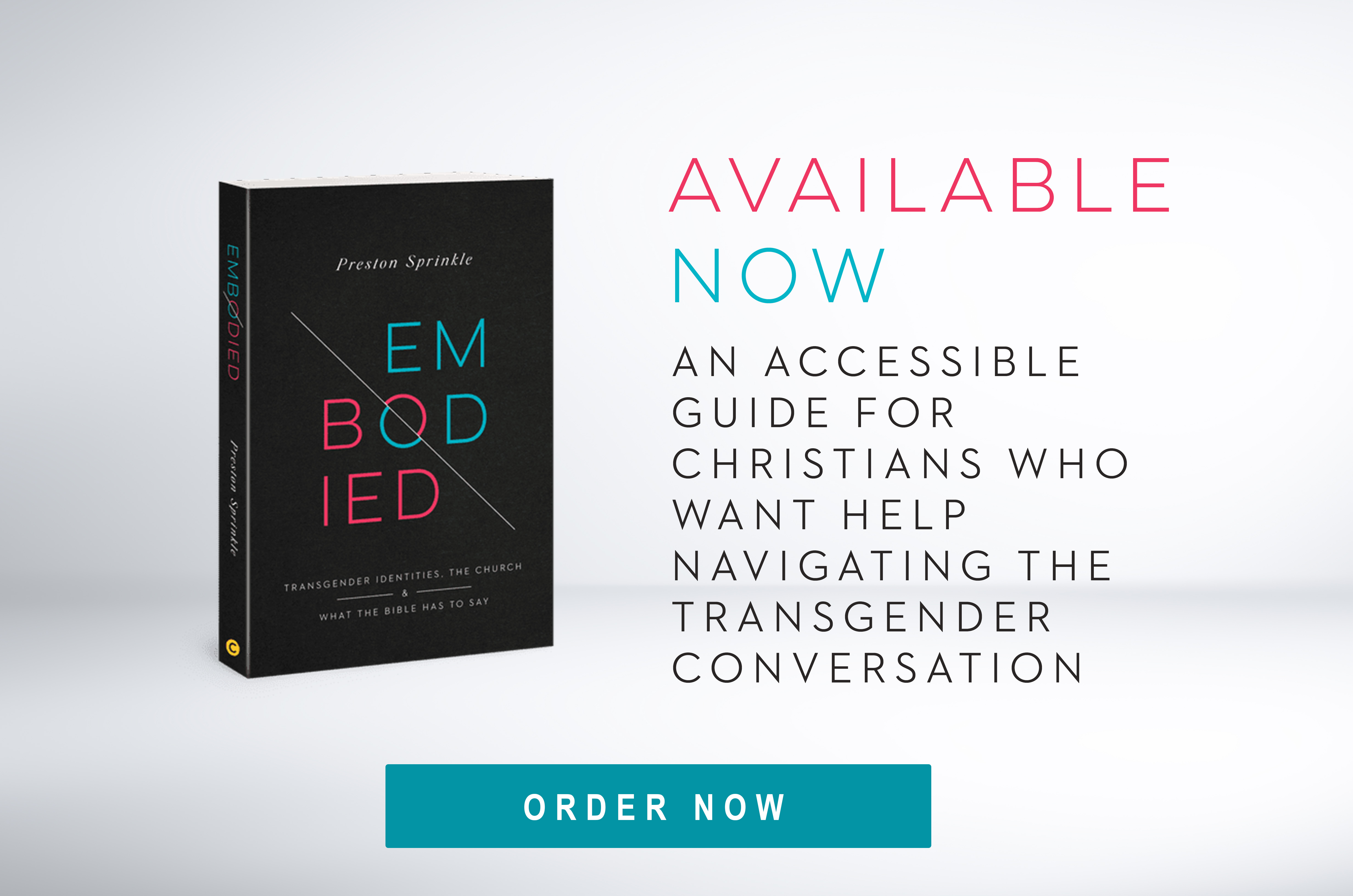
This blog series is drawing from the research paper: “The Problems with Correlating Sexual Orientation Change Efforts and Gender Identity Change Efforts,” available for free here. Written by Drs. Paul Eddy and Preston Sprinkle.
In the previous post, we discussed the language problem that’s built into the correlation between Sexual Orientation Change Efforts (SOCE) and so-called Gender Identity Change Efforts (GICE). The language problem is closely related to what I call the “ontological problem.”
The term “ontology” is a branch of philosophy that focuses on fundamental questions of being and existence.[1] One of the long-standing issues in ontology is the relationship between the mind and body, so it’s not surprising that questions surrounding gender identity and gender dysphoria force important questions regarding ontology. One main question is this:
If a human being experiences incongruence between their biological sex and their internal sense of self (gender identity), then which one are they—and why?
For instance, if a biological male’s internal sense of self is not male, then are they male or something else? One ontological response would be: a biological male with gender dysphoria is still a biological male. Another ontological response would be: a biological male whose internal sense of self is not male, is not male. In this case, one’s internal sense of self determines who a person really is, even if this conflicts with the body.
Buy Now!
Embodied: The Latest from Preston Sprinkle
My point in this post is not to argue for one perspective over another. I only want to point out that SOCE and GICE are working with two very different ontological categories. Sexual identities (gay, straight, bi) correlate with indisputable ontological realities. Someone who’s “gay,” for instance, is ontologically attracted to the same sex. (The ontological significance might be disputed, but the ontological reality—that they are attracted to the same sex—is not.[2]) But in the case of trans* identities, if one’s “internal sense of self as female” (gender identity), for instance, is incongruent with the fact that they are biologically female, this does, at the very least, raise some significant ontological questions.
Understanding these ontological differences is important for seeing the difference between SOCE and GICE, because SO and GI carry different ontological weight. Opponents of so-called GICE assume that one’s “internal sense of self” is who someone is; gender identity is more significant for personhood than one’s body. If someone experiences incongruence between body and mind, then, if something needs to be converted, it’s the body not the mind.
Maybethis is true. Again, my point is not to argue for one ontological position over another. But it takes a certain ontological perspective to assume that one’s internal sense of self is clearly who a person really is.
This, of course, brings us back to the shaky meaning of conversion, which we touched on in the previous post. Those who oppose SOCE are against conversion—period. But those who oppose GICE typically advocate for another kind of conversion, that of the body. One would have to assume that one’s sexed body is irrelevant (not as significant) for personhood in order to not consider this to bea kind of conversion. If the body is irrelevant for personhood, then changing the body is not converting the person. Rather, it’s aligning the body with who the person really is.
In short, SOCE and GICE rely on different assumptions about human nature. Therefore, correlating SOCE with GICE faces several ontological challenges.
First, the desistence challenge. We’ll address this more thoroughly in a future post. To put it briefly: gender identity is often intertwined with gender dysphoria. Typically, one’s internal sense of self as male or female is only reflected on if the person experiences some level of gender dysphoria. And as stated earlier, around 80% of children with gender dysphoria end up desisting by going through puberty. The same is not true of sexual orientation. We don’t at all see the same kind of desistence rate for same-sex attraction. While people may experience fluidity within their sexual orientation (especially women), sexual orientation itself is much more stable.
Sexual orientation is far more stable than gender identity, and even more stable than them both is the sexed body (except for some intersex conditions like guevedoces).
Second, there’s the identity challenge. In modern, western culture, it’s common to build an identity around one’s subjective, autonomous, individual sense of self and one’s self-expression. (Carl Trueman has recently shown that this way of constructing identity has deep philosophical and psychological roots that have more recently trickled down into popular thinking.[3]) The idea of an objective, divinely created, unchosen authority telling you who you are—i.e. the sexed body—is not only foreign to the western imagination but downright offensive. The obstinate givenness of human somatic existence is seen not as a grounding point to be celebrated, but as a threat to unfettered individual autonomy and self-expression that must be overcome. One has to assume this western view in order to view the thing we now call GICE as a threat to human identity.
The third challenge is a theological one and will therefore only appeal to my Jewish or Christian readers. According to Judeo-Christian theology, the body is essential to our image bearing status.[4] Genesis 1 connects human identity (as image bearers) with our sexed bodies:
God created mankind in his own image,
in the image of God he created them;
male and female he created them. (Gen. 1:27)
This passage elicits many debates and interpretive questions, but the one thing that’s clear is that our bodies are essential to bearing God’s image. (Notice the poetic correlation between “image” and “male and female”.) The Hebrew word for “image” is tselem, and it almost always refers to “idols” throughout the Old Testament. The term basically means the physical “carved or hewn statue or copy” of a nonphysical being. Idols, in other words, are visible representations of an invisible deity. In Genesis 1, the idol is humanity, and the nonphysical being is Yahweh. The image of God is “a declaration that God intended to create human persons to be the physical means through which he would manifest his own divine presence in the world.”[5] We are God’s idols—visible representations of God on earth. This means that the most fundamental statement about human nature (we bear “God’s image [tselem]”) highlights our embodied nature. And not just embodied nature, but our sexed embodied nature. We bear God’s image as male and female.6
There is a fourth problem related to ontology; it’s what I call the “diagnostic problem.” It’ll take a while to unpack so I’ll cover it in the next post. To sum up this post: SOCE and GICE deal with very different ontological questions and realities. Citing the two in tandem—“sexual orientation and gender identity change efforts”—reveals a certain level of philosophical, scientific, and theological ignorance that will ultimately have an effect on the lives of real people who are wanting to explore non-invasive ways to reduce or eliminate their dysphoria. Labeling all non-invasive therapeutic models of care as Gender Identity Change Efforts is a linguistic game that helps no one.
[1] The term ontology is also used, for example, in the field(s) of medicine and health care to refer to a shared lexicon of terms, concepts and information within a specific domain. E.g., C. A. Kronk, G. Q. Tran, and D. T. Y. Wu, “Creating a Queer Ontology: The Gender, Sex, and Sexual Orientation (GSSO) Ontology,” Studies in Health Technology and Informatics 264 (2019), 208-12.
[2] Here, I’m thinking of the debate over gay identities within some evangelical circles. Some are concerned that gay identities invest too much ontological significance in one’s sexual orientation vis a vis one’s identity in Christ. But most critics who raise these concerns won’t deny that some people are attracted to the same sex.
[3] The Rise and Triumph of the Modern Self: Cultural Amnesia, Expressive Individualism, and the Road to Sexual Revolution (Wheaton: Crossway, 2020).
[4] The following point is a summary of pp. 64-65 of my book Embodied: Transgender Identities, the Church, and What the Bible Has to Say (Colorado Springs: David C. Cook, 2021).
[5] Marc Cortez, ReSourcing Theological Anthropology: A Constructive Account of Humanity in
the Light of Christ (Grand Rapids, MI: Zondervan, 2017), 109.

